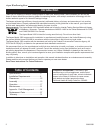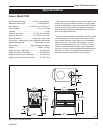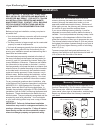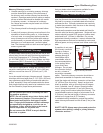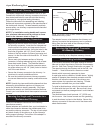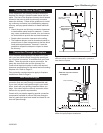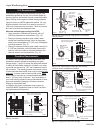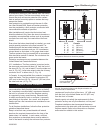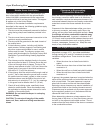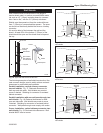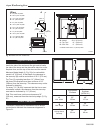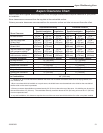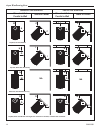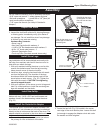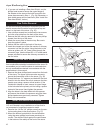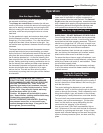
10
Aspen Woodburning Stove
30000369
Clearance to Surrounding
Combustible Materials
When the stove is operating, both the stoveplate and
the chimney connector radiate heat in all directions. A
safe installation requires that adequate clearance be
maintained between the stove and nearby combustible
materials to ensure that those materials do not over-
heat.
Clearance is the distance between either your stove
or chimney connector, and nearby walls, floors, the
ceiling, and any other fixed combustible surface. Keep
furnishings and other combustible materials away
from the stove as well. In general, a distance of 48”
(1219 mm) must be maintained between the stove and
moveable combustible items such as drying clothes,
furniture, newspapers, firewood, etc. Keep this area
empty of any combustible material.
Safe Ways to Reduce Clearances
The Aspen clearance requirements, listed and
diagramed on pages 10-11, have been established
through testing to UL and ULC standards to meet most
installation configurations. These involve four basic
variables:
• When the stove has no listed heat shield in-
stalled.
• When the stove does have a listed heat shield
mounted on it.
• When the wall has no listed heat shield installed.
• When the wall does have a listed heat shield
mounted on it.
In general, the greatest clearance is required when the
stove will be positioned with no heat shield near a wall
with no heat shield. The least clearance is required
when both the stove and the wall have heat shields.
Reducing a stove clearance may require installation of
a listed heat shield on the chimney connector as well.
Clearances may be reduced only by means approved
by the regulatory authority, or in accordance with the
clearances listed in this manual.
When determining clearance, always measure from
the top plate of the stove, or, from the chimney connec-
tor itself, to the adjacent combustible surface. Do not
measure from the heat shields of the stove or connector
to the combustible surface.
Mobile Home Installation
The Aspen is approved for use in manufactured (mo-
bile) homes when installed with the optional Mobile
Home Kit #1898 in accordance with the instructions
provided with that kit and any local codes. This approv-
al applies only in the United States.
In addition to the standard installation requirements
described in this manual, the following guidelines apply
to mobile home installations:
1. The stove must be permanently secured to the floor
using the leg clamps and fasteners provided in the
kit.
2. The stove must have a permanent connection to the
outside to supply combustion air.
3. The stove must be grounded to the steel chassis of
the mobile home.
4. A listed chimney system, including roof thimble,
spark arrestor, chimney supports, roof flashing and
any other components suitable for use in mobile
homes must be used. The chimney system must
comply with the standard for Chimneys Factory-Built
Residential Type and Building Heating Appliances
UL 103.
5. The chimney must be attached directly to the stove
and must extend at least 3’ (914mm( above the part
of the roof through which it passes. The top of the
chimney must extend at least 2’ (610 mm) above the
highest point of any part of the mobile home struc-
ture within 10’ (3 m) of the chimney.
6.
If the chimney exits the mobile home through a wall at
a point 7 feet or less above the ground level on which
the mobile home is located, a guard or other noncom-
bustible enclosure must be fitted at the point of exit
and extend up to a height of 7’ (2.1 m). Any openings
in this guard must be smaller than 3/4” (19 mm).
7. Check all local building codes, specifically those
related to mobile homes. Other requirements may
be applicable to chimney system removal for trans-
portation of the mobile home.
WARNING: Do not install the Aspen in a sleeping
room or hallway.
CAUTION: The structural integrity of the mobile
home roof, floor, walls and ceiling must be main-
tained.



